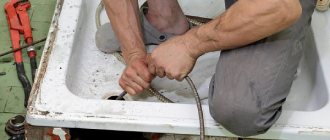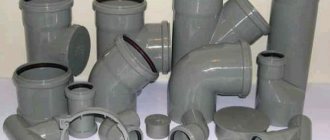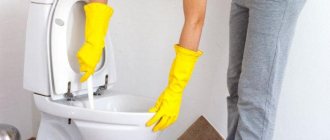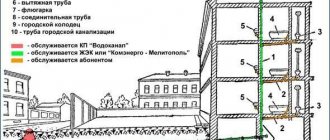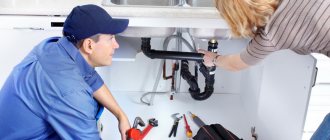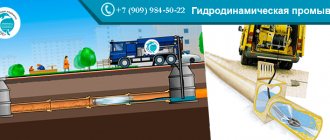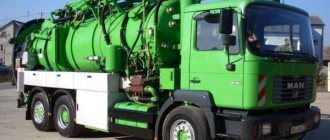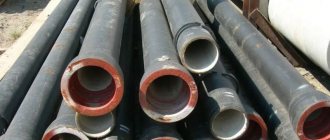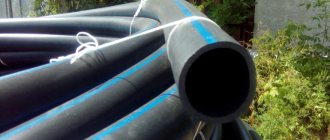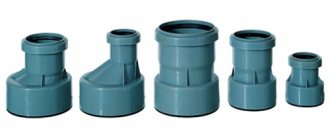Clogged sewer pipes are a problem that can arise in everyone’s apartment. You can cope with this task using a plunger and special solutions. But they cannot always help either. The most popular and affordable tool for clearing complex blockages is considered to be a flexible shaft or cable. For its manufacture, a steel, elastic, well-bending wire is used, on one end there is a handle, and on the other there is a threaded connection intended for attachments.
ATTENTION! A unique, highly effective product has been developed for cleaning sewer pipes, eliminating any blockages. The product is a concentrated mixture of enzymes that easily break down and process fat accumulations and any deposits of organic origin. One package of Saniclean will last you a whole year! Read more"
Depending on the complexity of the blockage, different types of nozzles are used. Most often they are sold as separate elements and are not included with the cable.
Types of sewer blockages
Blockages form for various reasons. This may be the negligence of the owner, who regularly pours greasy waste and large particles of household garbage into the sewer, or the inevitable natural growth of deposits during operation.
It is customary to distinguish the following types of blockages:
- Mechanical. There was construction debris and other foreign objects in the sewer.
- Operational. Particles of food waste, grease, hair or other small particles gradually accumulate on the inner surface of the pipeline walls.
- Mineral. Rust and lime deposits. Rust can form a blockage exclusively in a metal pipeline, while limescale deposits can be deposited on any materials. The rate of growth of lime deposits directly depends on the quality of the water.
It is important! Cast iron drains are considered to be the most prone to blockages. The material of such a pipeline is porous, and particles of grease and dirt easily settle on it. Plastic pipelines are less susceptible to this unpleasant phenomenon.
Types of plumbing cables
Due to the large number of manufacturers of plumbing cables, the options for making their cord and endings are quite varied. All devices are often united only by a handle for scrolling the cable along the axis. Almost all models are equipped with it.
According to their internal structure, cables are divided into the following types:
- cable;
- spring;
- spring-wound.
These cables are used for various blockages and require more detailed consideration.
Type #1: Rope Wire
The rope type of cable is the simplest solution for cleaning apartment drains. It has the form of a cord twisted from spirally twisted galvanized steel wires. Its thickness rarely exceeds 6 mm, and its length is usually 1.5-5 m.
Such a cable can be made independently from a piece of rope by constructing a device on one side that allows rotational movements.
Features of rope rope:
- Withstands high torque in the direction opposite to the curl.
- Wear-resistant and durable.
- Weak penetration force due to small diameter.
- High probability of dissolution at the end.
- Not elastic, but has good passage through pipes and sewer bends due to its small thickness.
This cable is suitable for clearing small operational blockages in apartments. Poorly cleans fibrous and hair plugs.
Type #2: spring-wound cable
The spring-wound cable is not professional and is used on a par with the rope type for domestic purposes.
It represents a spring wire wound around a central void. The thickness varies between 5-10 mm, and the length is 2-5 meters.
The spring cable is cheap and takes up little space. Thanks to its ribbed structure, it cleans pipe walls well along the entire length
Features of the spring-wound cable:
- Withstands strong torque in the direction opposite to the curl.
- Very flexible, prone to forming loops in wide pipes.
- It is impossible to pull without irreversible longitudinal deformations if the end of the cable gets caught.
- Goes well around sewer bends.
- Not equipped with attachments.
- Difficult to maintain: hard-to-reach dirt accumulates in the internal cavity.
The flexibility of the spring does not allow creating a punching force, but the likelihood of damage to sewer joints is significantly reduced.
It is recommended to use a spring-wound cable to clear soft apartment blockages with a large number of bends in the sewer system.
Type #3: spring cable with core
The cable is a steel core made of twisted wire, which is wrapped around the outside with a spring spiral. The shaft diameter can be up to 30 mm, but the standard values are 13.5 mm and 16 mm. The length can reach 60 meters.
The spring cable is used not only for domestic needs, but also for breaking through severe blockages in intra-house risers and even in city sewers.
There are two main modifications of this cable:
- with a core rotating around the shell;
- with a rigidly fixed core.
Rigid-core devices are similar to rope-type cables. They consist of several layers of twisted wire, each of which is wound in the direction opposite to the previous layer. The last layer is wound in the form of a spring
The advantage of a spring cable with a rigid core is the ability to make a “rose” at the end of the rope without the risk of unraveling the overlying wires
The result is a cable that is incredibly strong and resistant to torsion in any direction. At the end there is usually a mount for a nozzle.
The rotation handle is attached directly to the inner shaft, and the cable holding sleeve is fixed to the outer shell
In a cable with a core rotating around the sheath, the last layer is wound with a gap. The end of the core has a mount for a nozzle. The twist handle is attached directly to the core.
This design allows you to push the cable inside the clogged pipe over a long distance and clear the clog with a nozzle only at the exit from the outer shell.
Features of core spring cable:
- withstands strong torque;
- has high penetration ability;
- sewer deposits do not spray out from the cable when twisting;
- not flexible, does not fit into straight bends well;
- does not scratch the entire length of the pipe being cleaned;
- equipped with nozzles.
A spring cable with a rotating internal shaft is often used by professional plumbers, but at home it can also break through a blockage without any problems.
Methods for cleaning pipes when sewerage is clogged
The vast majority of homeowners prefer to use old, proven (although not always effective) methods to deal with sewer blockages:
- Using a plunger. The simplest method to use, which, however, can only help against small blockages.
- The use of special chemical reagents that decompose organic compounds. The method is effective, but it is undesirable to use it for plastic pipelines, which may simply not withstand aggressive chemical exposure.
- Mechanical cleaning with a special plumbing cable. In pipelines made of plastic materials, this cleaning method should also be used with caution. In addition, flexible cable will be difficult to use in pipelines with a large number of bends or turns.
- Folk recipes. Using salt, soda and vinegar in various proportions.
Note! None of the considered methods guarantees complete cleaning of the pipeline. The length of the cleared area will most likely be small.
Nowadays, the most effective cleaning technology is the use of hydrodynamic units.
We recommend that you read: How to flare or bead copper tubes with your own hands
The units are produced in several variations - from professional to compact (household). The former are distinguished by their impressive size and often operate on the basis of vehicles. The scope of application of such units is large main pipelines.
The latter are small devices that can be operated by one person. Such installations are suitable for servicing private households, apartments, and offices.
The nuances of flushing home sewerage
Video pipe inspection
Installations for flushing sewer pipes at home are easy to use and come with instructions. It describes in detail the steps to use the device. However, there are nuances, knowledge of which will help a beginner to cope with the task effectively:
- The holes on the attachment elements are located so that jet thrust is formed. It gives movement to the hose, so there is no need to push it with force.
- After being inserted into the sewer system, the flexible element is carefully moved in the direction of the riser.
- The hose is inserted not only into the inspection hatch, but also into the drain hole of the toilet or sink.
- After removing the blockage, the pipes are washed with a stream of hot water. It's a good idea to add a disinfectant cleaner.
- The hose part is removed from the pipeline only after the device is turned off.
Devices for cleaning pipelines are used for preventive cleaning and in the event of an accident. If you decide to buy such equipment, be guided by the length and diameter of the line, and when selecting nozzles, take into account the material from which the pipes are made. This will allow you to save money, because more powerful units are more expensive.
It is beneficial to buy attachments as a set so that you always have the necessary element at hand. To quickly detect blockages, get video equipment for telediagnosis.
With the right approach and choice of hydraulic equipment and nozzles, blockages of any complexity can be eliminated without the involvement of professionals.
Hydrodynamic cleaning technology
Hydrodynamics for sewer flushing involves careful treatment of the internal walls of the sewer with water supplied under high pressure (this figure is 100-200 atmospheres). This pressure has an effect on the pipe walls similar to treatment with a stiff brush.
At the end of the flushing, the pipe returns to the quality of a new product. In addition to this, plaque will accumulate much more slowly on a renewed smooth surface.
The design of the hydrodynamic installation is very simple. The device consists of several elements:
- Water compressor.
- Drive: for small household installations – electric. Bulky professional devices are often self-contained and powered by a gasoline or diesel engine.
- A hose through which water is supplied under pressure.
- Tip with nozzle.
Before starting the cleaning procedure, the optimal pressure level for the pipeline is set. In household networks, this figure, as a rule, should not exceed 150 atmospheres. Higher values are fraught with damage at pipeline joints.
Next, the end of the hose with the nozzle is placed into the pipe through a special inspection hatch, toilet drain, or other suitable hole. The compressor is connected to the power source, and liquid begins to flow under pressure. Powerful jets of water propel the hose along the pipe, simultaneously destroying any blockages that get in its way. The installation operator can control the passage of the installation and, if necessary, adjust the pressure level.
After eliminating the blockage (at this moment the accumulated water will begin to quickly drain), it is worth running the unit several times along the same section in order to thoroughly clean the problem area.
We recommend that you read: How to make a spark arrestor for a chimney with your own hands?
Definition and purpose of nozzles
Design options for nozzles for sewer cleaning
Nozzles for sewer cleaning are used in the hydrodynamic method of pipeline cleaning. They are connected to a powerful apparatus hose inserted into the drain hole, which, under high water pressure, is capable of removing plaque from the internal surfaces of pipes and eliminating even hard blockages and nitrous oxide.
Previously, this technique was only the final stage after cleaning with a cable, but now, thanks to powerful pumps, you can do without mechanics.
This method is optimal for plastic lines, as it minimizes the risk of damage to the pipe walls.
For work, special-purpose hydrodynamics and car wash devices are used. Attachment elements that make washing more efficient are connected to both devices.
Types of nozzles for hydrodynamic installation
The efficiency of the hydrodynamic machine in each specific case directly depends on the correct choice of nozzle. There are several types of nozzles:
- Universal. Best suited for servicing short-distance domestic sewer networks. Universal nozzles provide good maneuverability, which allows cleaning to be carried out in the shortest possible time.
- Rotary. During operation, the nozzle rotates around its axis, due to which jets of water act on blockages at constantly changing angles. Effective in the fight against fat deposits.
- Garnet-shaped. Area of application: large-diameter main pipelines. They feature a powerful cleaning jet and increased traction.
- Triangular. Designed for complex blockages that cannot always be dealt with using universal nozzles. Due to its shape, the cutting and sawing effect of the pointed edges is added to the effect of water jets.
- Bottom. Designed for cleaning drainage systems and storm sewers, where sediments mostly accumulate at the bottom of the pipeline. The shape of the nozzle resembles a thickened spatula, equipped with a wedge-shaped end with nozzles.
Note! The kit should definitely have a universal nozzle. It (albeit with less functionality) can replace any other.
The nozzles also differ in the number of jets. There can be one jet (central), or several, evenly distributed on the front of the device.
Any nozzle is equipped with direct and reverse type nozzles. The first ones throw out jets of water along the direction of movement, and are responsible for clearing blockages. Secondly, the liquid jets are directed backwards, providing the installation with the jet thrust necessary to move through the pipeline.
Nozzles for mechanical pipe cleaning ROTHENBERGER
Moscow St. Petersburg Novosibirsk Ekaterinburg Nizhny Novgorod Samara Omsk Kazan Chelyabinsk Rostov-on-Don Ufa Perm Volgograd Krasnoyarsk Voronezh Saratov Krasnodar Tolyatti Barnaul Izhevsk Ulyanovsk Yaroslavl Vladivostok Khabarovsk Irkutsk Novokuznetsk Tyumen Orenburg Kemerovo Ryazan Penza Embankment ny Chelny Tula Lipetsk Astrakhan Tomsk Makhachkala Kirov Cheboksary Kaliningrad Bryansk Magnitogorsk Ivanovo Kursk Nizhny Tagil Stavropol Arkhangelsk Belgorod Ulan-Ude Vladimir Sochi Kaluga Kurgan Orel Murmansk Smolensk Vladikavkaz Cherepovets Volzhsky Chita Saransk Surgut Vologda Tambov Kostroma Kostroma Komsomolsk-on-Amur Nalchik Petrozavodsk Sterlitamak Taganrog Bratsk Dzerzhinsk Yoshkar-Ola Orsk Mines Yakutsk Hangar SK Nizhnevartovsk Novorossiysk Syktyvkar Nizhnekamsk Biysk Grozny Stary Oskol Prokopyevsk Rybinsk Norilsk Blagoveshchensk Engels Balakovo Petropavlovsk-Kamchatsky Pskov Severodvinsk Armavir Zlatoust Balashikha Kamensk-Uralsky Khimki Syzran Podolsk Novocherkassk Korolev Yuzhno-Sakhalinsk Volgodonsk Nakhodka Berezniki Abakan Mytishchi Lyubertsy Rubtsovsk Maykop Salavat Ussuriysk Mia ss Kovrov Kolomna Elektrostal Almetyevsk Pyatigorsk Kopeysk Pervouralsk Nazran Odintsovo Nevinnomyssk Kislovodsk Dimitrovgrad Novomoskovsk Novocheboksarsk Khasavyurt Serpukhov Orekhovo-Zuevo Murom Kamyshin Zheleznodorozhny Neftekamsk Novy Urengoy Cherkessk Noginsk Novoshakhtinsk Nefteyugansk Shchelkovo Yelets Achinsk Novokuibyshevsk Sergiev Posad Noyabrsk Kyzyl Oktyabrsky Derbent Seversk Leninsk-Kuznetsky Arzamas Obninsk Between Rechensk Ukhta Kiselevsk Novotroitsk Bataysk Elista Artem Zhukovsky Velikiye Luki Kansk Magadan Tobolsk Abramtsevo Alabino Aprelevka Arkhangelskoye Ashitkovo Baikonur Baksheevo Barybino Beloomut White Pillars Borodino Bronnitsy Bykovo Valuevo Verbilki Vereya Vidnoye Vnukovo Leader of the Proletariat Volokolamsk Voronovo Voskresensk East Vostryakovo Vysokovsk Golitsino Dedenevo Dedovsk Dmitrov Dolgoprudny Domodedovo Dorokhovo Drezna Dubki Dubna Egoryevsk Zhilevo Zagorsk Zagorya Zaprudnaya Zaraysk Zvenigorod Zelenograd Ivanteevka Iksha Ilyinsky Istra Kashira Kerva Klimovsk Klin Klyazma Kozhino Kokoshkino Kolyubakino Kosino Kotelniki Kraskovo Krasnoarmeysk Krasnogorsk Krasnozavodsk Krasnoznamensk Krasny Tkach Kryukovo Kubinka Kupavna Kurovskoye Forest Town Likino-Dulevo Lobnya Lopatinsky Losino-Petrovsky Lotoshino Lukino Lukhovitsy Lytkarino Lvovsky Malakhovka Mikhailovskoye Mikhnevo Mozhaisk Monino Mukhanovo Narofomin sk Nakhabino Nekrasovka Nemchinovka Novobrattsevsky Novopodrezkovo Obukhovo Necklace Lakes Opalikha Pavlovsky Posad Pervomaisky Sands Pirogovsky Polushkino Pravdinsky Privokzalny Proletarsky Protvino Pushkino Pushchino Radovitsky Ramenskoye Reutov Reshetnikovo Springs Roshal Rublevo Ruza Saltykovka Northern Silver Ponds Solnechnogorsk Solntsevo Sofrino Staraya Kupavna Starbeevo Stupino Skhodnya Taldom Tekstilshchik Tempy Tishkovo Tomilino Troitsk Tugolessky Bor Tuchkovo Uvarovka U efficient Uspenskoe Firsanovka Phosphorite Fryazino Fryanovo Khorlovo Khotkovo Cherkizovo Chernogolovka Cherusti Chekhov Sharapovo Shatura Shaturtorf Shakhovskaya Sheremetyevsky Shcherbinka Elektrogorsk Elektrougli Yakhroma Alexandrovskaya Boksitogorsk Bolshaya Izhora Budogoshch Ascension Volosovo Volkhov Vsevolozhsk Vyborg Vyritsa Vysotsk Gatchina Druzhnaya Gorka Dubrovka Efimovsky Zelenogorsk Ivangorod Kamennogorsk Kikerino Kingisepp Kirishi Kirovsk Kobrinskoe Kolpino Communard Kronstadt Lisiy Nos Lodeynoye Pole Lomonosov Meadows Pavlovsk Pargolovo
Advantages and disadvantages of the method
The use of hydrodynamic installations has a number of undeniable advantages:
- The inner walls of the pipes are not damaged. The pressure of water, even such a strong one, is not capable of harming solid material.
- The cleaning procedure takes relatively little time. For a standard apartment, one hour will be enough; completely cleaning the sewer in a large private house will take 3-4 hours.
- No harmful chemical compounds are used during the work.
- After hydrodynamic flushing, the throughput of the pipeline increases to its original level. Other methods do not guarantee such a result.
- The hose of the hydrodynamic unit bends easily, which makes it possible to equally successfully use it both on straight and on turning sections.
- The device is able to function effectively at subzero temperatures, when other cleaning methods will be powerless due to ice jams. Here it will be enough to simply supply hot water to the device.
- The hydrodynamic machine not only removes blockages, but completely flushes the pipeline.
We recommend that you read: How to make scaffolding from a profile - drawings and instructions
Among the negative aspects are the high financial costs of carrying out the procedure (however, it is not necessary to buy a flushing system - you can rent it, or order a similar service from specialists). In addition, the device consumes large volumes of water. Thus, to clean large main pipelines, about 300 liters of water per minute will be required. Economical household models consume about 20 liters per minute.
In order to avoid having to deal with the problem of blockages for as long as possible, you should use your sewer system as carefully as possible. It is worth installing a grate at each drain hole to retain large particles of debris. To combat fat deposits, you need to regularly pour hot water down the drain with the addition of special chemicals.
Attachment for drill or screwdriver
If there is little water flow in the bathroom, the sink is clogged, or there is an unpleasant smell in the kitchen that cannot be removed with a freshener, you need to act immediately. With the help of Saniclean you can easily cope with the situation without a plumber... Read more»
A convenient product for clearing blockages in sinks, bathtubs, and toilets. The end of the wire is inserted into the pipe, and when the trigger is pressed, the spiral itself begins to move forward, easily overcoming the bends of the pipe.
The turntables are designed to remove blockages in pipes with a diameter of up to 40 mm. The spiral size reaches up to 7 meters. It is easy to operate manually, as they are equipped with a convenient handle for rotation. Removable attachments for turntables are brushes and scrapers; There are straight, cone-shaped, pear-shaped. The nozzles can be used to clean ventilation and chimney systems.
Which cable is better to choose?
Before purchasing a plumbing cable, you need to decide on the factors that influence the choice of model.
These include:
- Maximum length from siphon to riser . You should not take a cable longer than this distance by more than 1 meter.
- Diameter of sewer pipes . The wider they are, the wider the cable must be, otherwise it may twist.
- Number of pipe turns . Most cored cables are designed for cleaning horizontal pipes and do not bend well at right angles.
When purchasing, preference should be given to those models that have a handle, a tip for screwing attachments, as well as an internal and external shaft.
A cable that is too thick will bend poorly at turns in the sewer system, and a cable that is too thin will twist into loops inside the pipe (+)
Cables with mechanical and electrical torsion devices are very convenient, but they are not cheap, so their purchase is determined mainly by a person’s financial capabilities.

